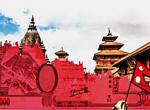Goa’s Aguad Port and Jail Complex in Sinquerim have been in the limelight since April 2024 for hosting an exhibition showcasing India’s ancient couture, India’s epic tales and historical narratives, and the profound symbolism of the lotus in Indian culture, dating back more than 4,000 years, under the banner ‘India’s Civilizational Marvels’. The expositions shine a spotlight on aspects of India's rich cultural heritage that history books and academicians have viewed as mere footnotes in ancient Indian history. The expositions, namely ‘Indian Fashion, Timeless Elegance’, ‘Sahitya Chitravali’ and 'Kamal', are methodically curated by Shri. Raghvendra Singh, a former member of the Indian Administrative Service who has headed nationally significant institutions like the National Archives of India, the National Museum, the Nehru Memorial Museum and Library, etc. According to the curator, the expositions offer insights into the subtleties of the country’s legacy and spark curiosity about the treasures hidden in Indian manuscripts, sculptures and paintings.
"Indian Fashion, Timeless Elegance" provides a glimpse into the evolution of classical Indian couture dating back almost 4,000 years, including the Harappan culture, Bharhut, Gandhara, Mathura, and Sanchi masterpieces. It depicts the aesthetic sensibilities, refinement, delicate materials and intricate craftsmanship associated with fashion depicted in ancient Indian sculptures, paintings and jewellery. The ancient sartorial choices, detailed embroidery, exquisite gold jewellery and classic adornments, including headgear and footwear, take centre stage. The exposition not only honours the past but also inspires contemporary fashion, proving that Indian couture’s elegance is truly timeless. The Yakshi sculptures on the railings of the stupa in Bharhut are depicted wearing lower garments so fine that it becomes difficult to discern the textile from the skin. Cave paintings from Ajanta showcase a diverse array of garments with intricate patterns and colours. This exposition focuses on classical fashion practices through Kesha, or hairstyle; Shirabhushanam, i.e. ornaments of the head including the headgear and earrings; Patta, or the garment, which explores the brilliance of the textiles categorised into Uttariya (upper garment) and Antariya (lower garment); Kati, or the intricately designed waistbands, Paduka (footwear) and Alamkar (jewellery).
The ‘Sahitya Chitravali’ takes the visitors on a visual voyage depicting Indian epics, philosophical treatises, classical Sanskrit dramas and Indian literature. It highlights the Mahabharat and the Ramayan and their influence on moral thought, as well as the ancient literature in India, including the works of great poets like Kalidas and Tulsidas. The exhibition also focuses on the themes of Sringar (beauty), Sangeet (music) and Nayak-Nayika (hero-heroine). The exhibition depicts the eight different types of Nayika, or heroines, under the umbrella term Ashta-Nayika in different stages of relationship with her Nayak, illustrating the Nayika’s desire, love, happiness, sorrow, regrets, hatred and passion. The exhibition also depicts an exhaustive collection of melody and raag (melodic structure in Hindustani classical music). It connects us to our literary heritage with the help of the Sanskrit literature and other literature in regional languages.
The ‘Kamal’ display explores the profound symbolism of the Lotus in Sanatan Dharma, Jainism and Buddhism. Kamal, or lotus, is omnipresent in the religious iconography and mythology of all the Indic religions. The lotus represents purity, enlightenment and detachment. It occupies an irreplaceable position in art and sculpture and has a powerful presence in India’s civilizational ethos. The lotus is also the national flower of India. This display affirms the Lotus's vital importance in the spiritual and cultural fabric of India and beyond by capturing its significant presence in Indian art and literature.
The exhibition on ‘India’s Civilizational Marvels’ holds immense significance as it serves as a platform to promote cultural exchange, foster greater understanding and appreciation of India's cultural heritage, and strengthen cultural ties between India and the global community. By showcasing India's civilizational achievements, the expositions inspire future generations to preserve and build upon this rich legacy. They reaffirm India's position as a custodian of one of the world's oldest and most enduring civilizations.
(The paper is the author’s individual scholastic articulation. The author certifies that the article/paper is original in content, unpublished and it has not been submitted for publication/web upload elsewhere, and that the facts and figures quoted are duly referenced, as needed, and are believed to be correct). (The paper does not necessarily represent the organisational stance... More >>
Image Source: https://media.assettype.com/gomantaktimes%2F2024-04%2F8c073663-9932-4028-9094-90f278583d3d%2FImage_2__2_.jpg











Post new comment